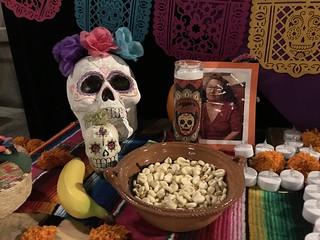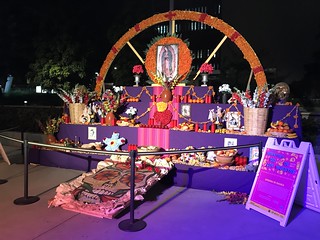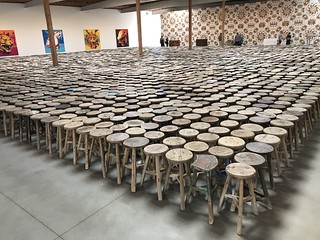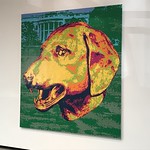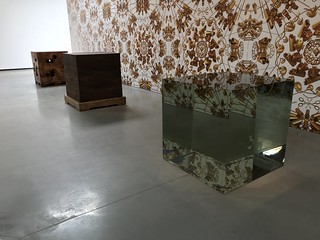 What a sassy, saucy period drama about two clever strong-willed women who contested the position of the Queen’s favorite. While men may have thought they were pushing the women around, it was these women who ruled England. Creatively based on a real historical rivalry, The Favourite provides intrigue worthy of Game of Thrones (and protagonists every bit as formidable as Daenerys and Cirsei), but also tempered with a wry sense of humor at times. Rachel Weisz and Emma Stone are both breathtaking in their performances of these incisively-written characters, complimented by Olivia Colman’s fragile, mercurial Queen Anne. The visuals are lush of the Jacobean opulence, while reminding you that even the most powerful were never too far from the mud, and the sanitation and medicine were more medieval than modern. The direction, along with an intense soundtrack (sometimes more sounds than music), was impressive and made for some memorable scenes. The rivals’ conversations over pigeon-shooting had subtext you could cut with a knife, and the scene of Emma Stone’s honeymoon night is startingly funny. The ending was unexpected (compounded by my knowing just enough of the actual history to be confused), but the sort that forces you to go back and rethink what you thought about all of the characters. As in Game of Thrones, there is unexpected nuance to all of them, and even those who may seem black-or-white are grayer than you first think.
What a sassy, saucy period drama about two clever strong-willed women who contested the position of the Queen’s favorite. While men may have thought they were pushing the women around, it was these women who ruled England. Creatively based on a real historical rivalry, The Favourite provides intrigue worthy of Game of Thrones (and protagonists every bit as formidable as Daenerys and Cirsei), but also tempered with a wry sense of humor at times. Rachel Weisz and Emma Stone are both breathtaking in their performances of these incisively-written characters, complimented by Olivia Colman’s fragile, mercurial Queen Anne. The visuals are lush of the Jacobean opulence, while reminding you that even the most powerful were never too far from the mud, and the sanitation and medicine were more medieval than modern. The direction, along with an intense soundtrack (sometimes more sounds than music), was impressive and made for some memorable scenes. The rivals’ conversations over pigeon-shooting had subtext you could cut with a knife, and the scene of Emma Stone’s honeymoon night is startingly funny. The ending was unexpected (compounded by my knowing just enough of the actual history to be confused), but the sort that forces you to go back and rethink what you thought about all of the characters. As in Game of Thrones, there is unexpected nuance to all of them, and even those who may seem black-or-white are grayer than you first think.
Saturday, November 24, 2018
FILM: The Favourite
 What a sassy, saucy period drama about two clever strong-willed women who contested the position of the Queen’s favorite. While men may have thought they were pushing the women around, it was these women who ruled England. Creatively based on a real historical rivalry, The Favourite provides intrigue worthy of Game of Thrones (and protagonists every bit as formidable as Daenerys and Cirsei), but also tempered with a wry sense of humor at times. Rachel Weisz and Emma Stone are both breathtaking in their performances of these incisively-written characters, complimented by Olivia Colman’s fragile, mercurial Queen Anne. The visuals are lush of the Jacobean opulence, while reminding you that even the most powerful were never too far from the mud, and the sanitation and medicine were more medieval than modern. The direction, along with an intense soundtrack (sometimes more sounds than music), was impressive and made for some memorable scenes. The rivals’ conversations over pigeon-shooting had subtext you could cut with a knife, and the scene of Emma Stone’s honeymoon night is startingly funny. The ending was unexpected (compounded by my knowing just enough of the actual history to be confused), but the sort that forces you to go back and rethink what you thought about all of the characters. As in Game of Thrones, there is unexpected nuance to all of them, and even those who may seem black-or-white are grayer than you first think.
What a sassy, saucy period drama about two clever strong-willed women who contested the position of the Queen’s favorite. While men may have thought they were pushing the women around, it was these women who ruled England. Creatively based on a real historical rivalry, The Favourite provides intrigue worthy of Game of Thrones (and protagonists every bit as formidable as Daenerys and Cirsei), but also tempered with a wry sense of humor at times. Rachel Weisz and Emma Stone are both breathtaking in their performances of these incisively-written characters, complimented by Olivia Colman’s fragile, mercurial Queen Anne. The visuals are lush of the Jacobean opulence, while reminding you that even the most powerful were never too far from the mud, and the sanitation and medicine were more medieval than modern. The direction, along with an intense soundtrack (sometimes more sounds than music), was impressive and made for some memorable scenes. The rivals’ conversations over pigeon-shooting had subtext you could cut with a knife, and the scene of Emma Stone’s honeymoon night is startingly funny. The ending was unexpected (compounded by my knowing just enough of the actual history to be confused), but the sort that forces you to go back and rethink what you thought about all of the characters. As in Game of Thrones, there is unexpected nuance to all of them, and even those who may seem black-or-white are grayer than you first think.
Monday, November 12, 2018
BOOKS: Letter To My Palestinian Neighbor
Yossi Klein Halevi’s “Letters To My Palestinian Neighbor” is an extremely thoughtful and personal plea for dialogue from an Israeli Jew wanting to reach out to his Palestinian neighbors. Halevi lives on a hill in Jerusalem with a view from his apartment to another hill across the way where Palestinians live, a very short distance away as the land lies, yet vastly separated by politics, not to mention a physical wall. He imagines a neighbor on that other hill, and what he would like to tell him about his own life and beliefs. Halevi is a religious Jew and devoted to Israel, but also very open-hearted towards the Palestinians, among whom he had traveled and made some friendships in the years before it became no longer possible for a Jew to travel safely in the West Bank. He has written other books about those travels, but in this book, he starts from the premise that any hope for reaching a common understanding has to begin with hearing each other’s stories and really understanding where the other is coming from. This book is his attempt to start that conversation, articulating in a very personal and sensitive way the Jewish Israeli perspective, including some great insights on the Jewish connection to the land of Israel, the sense of being a distinct Jewish people, and the tensions inherent in a Jewish democratic state. Many of his letters are written on a particular holiday, and begin with his observations on that holiday. He does an amazing job of staking out his positions in a way that is very honest, personal, and non-confrontational, always keeping in mind a respect for the Palestinian he is addressing. Even though these letters are not written to a specific known person, his device is to imagine a specific hypothetical neighbor on that other hill, and to address that neighbor personally, one on one, rather than being more generic. The device works well, I think, to keep his letters very personal and heartfelt. I learned a lot from this book, both about Judaism and about Israeli politics. While the situation remains grave, the fact that there are Israelis like Yossi Klein Halevi strengthens my hope for a path forward.
Saturday, November 10, 2018
FILM: Boy Erased
Boy Erased is a well done film, tightly written, with strong performances from its leads, particularly Lucas Hedges as a 19-year old Baptist preacher’s son in small town Arkansas who attempts a Christian ex-gay conversion therapy program. It’s hardly a spoiler alert to say that the program doesn’t work, but the core of the film is showing what actually goes on inside those soul-sucking places, interspersed with flashbacks of experiences that lead him there. While it could have easily slid into tendentious exposé, this film avoids that danger by presenting its characters with complexity. The boy goes into the program willingly, wanting to change, and his parents are not monsters, but loving parents who want the best for him. The evolution of their family dynamic provides the emotional frame to drive the storyline. The other participants in the program also provide a thoughtful variety of attitudes and reactions. Parts of this film are horrifying to watch (and could well be triggering for anyone who’s actually been subjected to these programs), but it’s ultimately satisfying and leaves you with hope that even LGBT kids from fundamentalist families in small-town Arkansas can turn out all right.
Saturday, November 03, 2018
Friday, November 02, 2018
Dia de los Muertos Festival in Grand Park DTLA
After dinner downtown, George and I wandered up to Grand Park where a Dia de los Muertos festival has been going on. The park is filled with offrendas, altars to departed loved ones piled with photographs, favorite foods, flowers, and memories. The first large, colorful one we came upon was by the local Oaxacan community. A few were personal, to a single person or family. But most of them were made by various civic groups, connecting specific remembrances to general themes, like one from a Latino LGBT group remembering those who had been ostracized by their family and had died way too young. Some extended the theme outside its original cultural roots, like one from a local group of Yemeni immigrants remembering their family members who have died back in war-torn Yemen. It reminded me a bit of the AIDS Quilt, in the power of a large scale built up out of particulars. So many photos of beloved grandparents or those cut off young, each with their own story. And it was also wonderful to see the people wandering the park engaging with these offrendas. Many of them were dressed up, in white skeleton faces, black dresses and suits, women with marigolds in their hair. I saw a father with a young son, the little boy in skeleton face and red hoodie, looking just like the kid from Coco, and the little boy was at an altar reading a placard with the story of the person pictured. It was so sweet. So glad that we came upon this. (View photo album.)
Samgyetang and Ai Weiwei
Today’s off-Friday explorations took me to Koreatown for lunch, and then to the Ai Weiwei: Zodiac exhibition at the new Jeffrey Deitch Gallery. In Koreatown, as I’ve learned, many of the really good places have one dish that they specialize in, and which may be all they offer. Today was one of those. Buil Samgye Tang (the signage was mostly in Korean) serves only samgye-tang, a chicken rice soup loaded up with all sorts of roots and herbs that are meant to cure colds and hangovers and assure good health. The basic model is a hot iron pot of boiling broth with a ginger-and-garlic-stuffed whole young chicken, rice, mung beans, jujube (a Korean date), and ginseng. The more deluxe versions add various other folk pharmaceuticals such as milk vetch (an herb) and ground deer antlers. A bowl of sea salt on the table allows you to season to taste. And as if a whole chicken rice pot isn’t enough, the meal comes with a traditional Korean plate of banchans to start – kim chee, pickled turnips, chicken gizzard bites, and crudites with a spicy-sweet soy paste. Ginger tea is served to wash it all down. The Korean staff were assiduously polite, with lots of smiling and bowing.
After lunch, I headed to the new Jeffrey Deitch Gallery in Hollywood. The gallery is in a former warehouse space that has been lightened up with paint and indirect natural light for optimal viewing in one very large space. Which is just what the featured Ai Weiwei work, Stools (2013), required. The work comprises nearly 3,000 wooden stools from the Ming and Qing dynasties collected from northern China. Most of the stools have the same basic three-legged design with a round seat, but every so often one varies in shape, design, or material. There are subtle differences in dimension, age, wear, and so on. The work fills an area 72-feet square. It gives the impression of a crowd where at first everyone in the crowd looks the same, but then you start to notice subtle differences. Its vastness invites you to engage with it from all sides, and to approach it at different levels, the pattern of its ordered arrangement creating all sorts of lines. It's surprising what a simple concept can do.
On two walls enclosing the stools are twelve very large works representing the twelve signs of the Chinese zodiac overlaid on world landmarks from major cities. These works read initially as paintings, but a closer examination reveals them to be constructed from LEGOs. One wonders if there is particular meaning in which animal overlays which city. The dragon overlays Beijing, with a small self-portrait of the artist worked in, swearing. A rather rabid looking dog overlays the White House. Hmm. On a third wall is a work entitled The Animal That Looks Like a Llama But is Really an Alpaca (2015), which is literally wallpaper. At first glance, it looks like classic French ormolu patterns, gilded objects in ornate designs. On closer inspection, one discovers that the objects are handcuffs and surveillance cameras, an ominous illustration of the artist's years of house arrest in his native China. Along this wall are five sculptural works, each a cube exactly one cubic meter in dimension, but each of different materials. Here Weiwei plays with the concept of a cubic meter, a standard measurement for shipping cargo, but each cube is of very different materials. One is wooden and forms an elaborate puzzle box. Another is a dark mass, which when you get close enough to see and smell it, turns out to be a huge block of tea. Another is perhaps the world's largest crystal, perfectly transparent, and bending light in all sorts of fun ways that beg for investigation. A solid white marble cube has brain coral-like carvings in it to give it texture. The fifth cube is a frame, made of exquisite blue-patterned porcelain. Near the front, Grapes (2017) takes a few more of those wooden stools, but reassembles them into an integrated spheroid, legs all radiating outward, looking almost like a creature that could start rolling. It's fascinating to look closely at how the stools were integrated, like a chain of Siamese twins, with the third leg of one being the first leg of another, and so on.
I was thrilled to enjoy these works of such a remarkable artist, and to enjoy them in an appropriately lit and capacious space, and frankly to have had the gallery nearly to myself for a time. Though I have to confess I'm still new to the private art gallery thing, and a bit intimidated. I mean, it's not a public museum, so isn't it really meant for people who might conceivably be thinking of purchasing thsee works? But in exhibitions like these, are the works even really on offer? I mean, some of them are monumental. If one is rich enough to buy something like Stools from a world-renowned artist, then I suppose one is rich enough to build a space to house it? Off to one side of the gallery entrance, there was a small desk where sat Jeffrey Deitch himself (I recognized the former MOCA director from photos in the LA Times) and a couple of assistants. I didn't approach them, and they didn't approach me. But at some point, I did notice that when certain other people entered, he would pop up and greet them. And at one point, I was close enough to overhear some conversation. They were breezily talking about who they'd met at Davos or the latest TED talk, or how they just had lunch with Frank Gehry. Deitch asked one woman if he had a current address for her. "Oh, well sometimes I'm in New York," she replied, "but sometimes I'm in the house in France, or in Switzerland. It's best just to mail me at the Foundation." Wow. Different circles than I'll ever run in. But I guess it's because of people like them that galleries like this can exist, and I can get to enjoy them.
After lunch, I headed to the new Jeffrey Deitch Gallery in Hollywood. The gallery is in a former warehouse space that has been lightened up with paint and indirect natural light for optimal viewing in one very large space. Which is just what the featured Ai Weiwei work, Stools (2013), required. The work comprises nearly 3,000 wooden stools from the Ming and Qing dynasties collected from northern China. Most of the stools have the same basic three-legged design with a round seat, but every so often one varies in shape, design, or material. There are subtle differences in dimension, age, wear, and so on. The work fills an area 72-feet square. It gives the impression of a crowd where at first everyone in the crowd looks the same, but then you start to notice subtle differences. Its vastness invites you to engage with it from all sides, and to approach it at different levels, the pattern of its ordered arrangement creating all sorts of lines. It's surprising what a simple concept can do.
On two walls enclosing the stools are twelve very large works representing the twelve signs of the Chinese zodiac overlaid on world landmarks from major cities. These works read initially as paintings, but a closer examination reveals them to be constructed from LEGOs. One wonders if there is particular meaning in which animal overlays which city. The dragon overlays Beijing, with a small self-portrait of the artist worked in, swearing. A rather rabid looking dog overlays the White House. Hmm. On a third wall is a work entitled The Animal That Looks Like a Llama But is Really an Alpaca (2015), which is literally wallpaper. At first glance, it looks like classic French ormolu patterns, gilded objects in ornate designs. On closer inspection, one discovers that the objects are handcuffs and surveillance cameras, an ominous illustration of the artist's years of house arrest in his native China. Along this wall are five sculptural works, each a cube exactly one cubic meter in dimension, but each of different materials. Here Weiwei plays with the concept of a cubic meter, a standard measurement for shipping cargo, but each cube is of very different materials. One is wooden and forms an elaborate puzzle box. Another is a dark mass, which when you get close enough to see and smell it, turns out to be a huge block of tea. Another is perhaps the world's largest crystal, perfectly transparent, and bending light in all sorts of fun ways that beg for investigation. A solid white marble cube has brain coral-like carvings in it to give it texture. The fifth cube is a frame, made of exquisite blue-patterned porcelain. Near the front, Grapes (2017) takes a few more of those wooden stools, but reassembles them into an integrated spheroid, legs all radiating outward, looking almost like a creature that could start rolling. It's fascinating to look closely at how the stools were integrated, like a chain of Siamese twins, with the third leg of one being the first leg of another, and so on.
I was thrilled to enjoy these works of such a remarkable artist, and to enjoy them in an appropriately lit and capacious space, and frankly to have had the gallery nearly to myself for a time. Though I have to confess I'm still new to the private art gallery thing, and a bit intimidated. I mean, it's not a public museum, so isn't it really meant for people who might conceivably be thinking of purchasing thsee works? But in exhibitions like these, are the works even really on offer? I mean, some of them are monumental. If one is rich enough to buy something like Stools from a world-renowned artist, then I suppose one is rich enough to build a space to house it? Off to one side of the gallery entrance, there was a small desk where sat Jeffrey Deitch himself (I recognized the former MOCA director from photos in the LA Times) and a couple of assistants. I didn't approach them, and they didn't approach me. But at some point, I did notice that when certain other people entered, he would pop up and greet them. And at one point, I was close enough to overhear some conversation. They were breezily talking about who they'd met at Davos or the latest TED talk, or how they just had lunch with Frank Gehry. Deitch asked one woman if he had a current address for her. "Oh, well sometimes I'm in New York," she replied, "but sometimes I'm in the house in France, or in Switzerland. It's best just to mail me at the Foundation." Wow. Different circles than I'll ever run in. But I guess it's because of people like them that galleries like this can exist, and I can get to enjoy them.
Subscribe to:
Comments (Atom)



